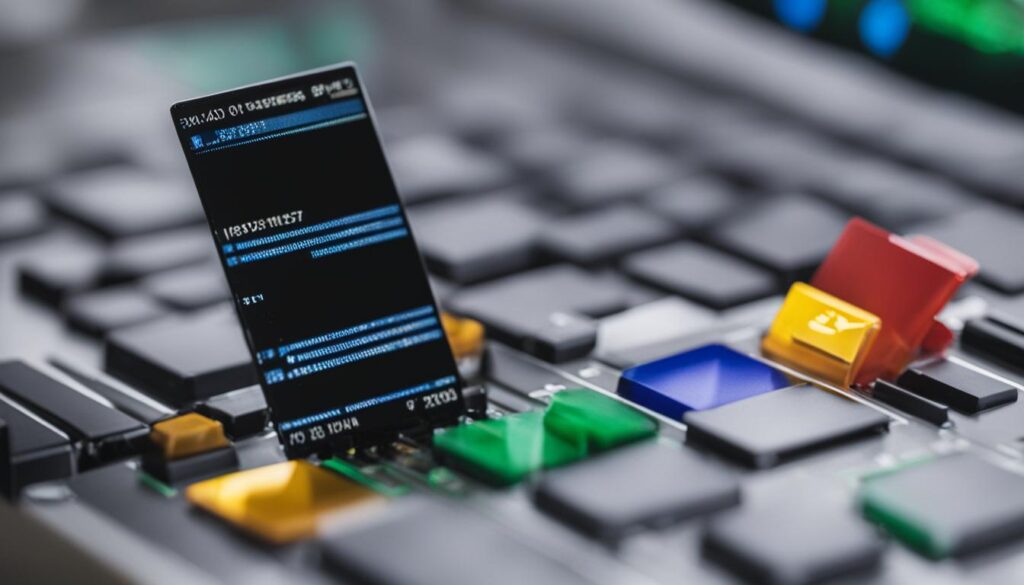Welcome to our essential guide on troubleshooting. Whether you’re dealing with complex machines, electronics, computers, or software systems, knowing how to troubleshoot effectively is a valuable skill. In this guide, we will provide you with valuable troubleshooting tips, techniques, and a step-by-step troubleshooting guide to help you become proficient in troubleshooting various issues.
When it comes to troubleshooting, it’s all about systematically finding and correcting issues. It involves gathering information, eliminating unnecessary components, and diagnosing the problem. By following a troubleshooting methodology, you can identify the root cause of a problem and implement appropriate solutions.
Throughout this guide, we will cover important aspects of troubleshooting, such as understanding troubleshooting methodologies, common troubleshooting scenarios, troubleshooting techniques and best practices, troubleshooting in the IT industry, troubleshooting with a CMMS (Computerized Maintenance Management System), troubleshooting methodology for CompTIA certifications, and the importance of documentation in troubleshooting.
So, whether you’re an IT professional, a maintenance technician, or someone who wants to enhance their troubleshooting skills, this guide is for you. Let’s dive in and explore the world of troubleshooting together!
Understanding Troubleshooting Methodologies
Troubleshooting methodologies are essential for effectively isolating and identifying the root cause of a problem. By following a systematic approach, you can streamline your troubleshooting process and resolve issues efficiently. This section will provide you with an overview of troubleshooting methodologies and best practices to help you become more proficient in troubleshooting.
One commonly used troubleshooting methodology involves a series of steps:
- Gathering information: This step involves collecting relevant data about the problem, such as error messages, system logs, or user reports. Having accurate information is crucial for determining the cause of the issue.
- Describing the problem: Clearly articulating the problem helps ensure that everyone involved has a shared understanding of the issue. Providing a detailed description will aid in the troubleshooting process.
- Determining the most probable cause: Based on the available information, you need to analyze and identify the potential causes of the problem. Consider factors such as recent changes, environmental conditions, or known issues.
- Creating a plan of action: Once the probable cause has been identified, you can develop a plan to address the issue. This plan should outline the steps and resources required to implement a solution.
- Implementing the solution: Execute the plan and apply the chosen solution. Be meticulous in following the steps outlined in the plan to ensure a successful resolution.
- Analyzing the results: After implementing the solution, evaluate the outcome to determine if the problem has been resolved or if further action is necessary. This analysis will help refine your troubleshooting skills.
- Documenting the process: Maintain a record of the troubleshooting steps taken, including any changes made and their results. Documentation serves as a reference for future troubleshooting efforts and facilitates knowledge sharing among team members.
By adhering to these step-by-step troubleshooting methodologies and employing best practices, you can enhance your troubleshooting skills and resolve issues in a systematic and efficient manner.
Common Troubleshooting Scenarios
Troubleshooting is applicable to various scenarios and can be used to address common issues that occur with operating systems, applications, CPUs, firewalls, hard drives, and servers, among others. By understanding these scenarios and their causes, you can be better prepared to troubleshoot and resolve similar issues that may arise in your systems or equipment.
Device Failures
Device failures are common troubleshooting issues that can occur due to hardware malfunctions, software conflicts, or compatibility issues. These failures can result in devices not functioning properly or even becoming completely unresponsive. To troubleshoot device failures, you can start by checking the connections and cables, ensuring that they are securely plugged in. You can also update device drivers, perform system diagnostics, or consider replacing the faulty hardware.
Unexpected Operation
Unexpected operation of systems or applications can be another common troubleshooting scenario. It can manifest as software crashes, error messages, or erratic behavior. To troubleshoot unexpected operation, you can try restarting the system or application, checking for software updates, and disabling any recently installed plugins or extensions. In some cases, analyzing log files or error messages can provide clues to the underlying issue and guide you towards a solution.
Other Anomalies
Other anomalies, such as slow performance, network connectivity issues, or data corruption, can also require troubleshooting. These anomalies can be caused by various factors, including software bugs, network congestion, or hardware malfunctions. Troubleshooting solutions for these anomalies may involve checking for malware or viruses, optimizing system settings, resetting network configurations, or performing data backups and restores.

Understanding and being able to troubleshoot common issues like device failures, unexpected operation, and other anomalies are essential skills for resolving technical problems effectively. By utilizing troubleshooting techniques and applying the appropriate solutions, you can minimize downtime, maximize system performance, and maintain the smooth operation of your systems and equipment.
Troubleshooting Techniques and Best Practices
When it comes to troubleshooting, employing specific techniques and following best practices can greatly enhance your problem-solving skills. Whether you’re dealing with software or hardware issues, these troubleshooting tips and techniques will help you effectively identify and resolve problems.
Gathering Information
One of the first steps in troubleshooting is gathering relevant information about the issue. This can include examining log files, error messages, and system documentation. By collecting all available data, you can gain valuable insights into the problem and its potential causes.
Questioning Users
When troubleshooting user-reported issues, it’s important to ask the right questions. Interacting with the user can provide additional context and help narrow down the scope of the problem. Be sure to gather details about error messages, recent changes, and any steps taken before the issue occurred.
Duplicating the Problem
If possible, try to duplicate the problem to better understand its behavior and identify the underlying cause. By replicating the issue in a controlled environment, you can effectively test different solutions and observe the problem in action.
Narrowing the Scope
When faced with complex issues, it can be helpful to narrow down the scope of the problem. This involves isolating specific components, subsystems, or processes to identify the root cause. By eliminating unnecessary variables, you can focus your troubleshooting efforts and expedite the resolution process.
Starting with Simple Solutions
When troubleshooting, it’s often best to start with simple solutions before moving on to more complex ones. Sometimes, the issue can be resolved by restarting the system, clearing caches, or checking connections. Implementing straightforward solutions first can save time and effort.
Keeping Documentation
Documenting your troubleshooting steps is essential for future reference and collaboration with colleagues. Keeping a record of the steps taken, tests performed, and solutions implemented can streamline future troubleshooting efforts and provide a valuable resource for troubleshooting similar issues in the future.
Verifying System Functionality
After implementing a solution, it’s crucial to verify that the problem has been resolved and the system is functioning as intended. This can involve testing specific functionalities, running diagnostic tools, or monitoring system performance. By confirming system functionality, you can ensure the problem has been successfully addressed.
By applying these troubleshooting techniques and best practices, you can improve your problem-solving skills and increase your chances of resolving issues effectively. Remember to gather information, question users, duplicate the problem, narrow the scope, start with simple solutions, document your steps, and verify system functionality. These strategies will make troubleshooting a more efficient and successful process.
| Technique | Description |
|---|---|
| Gathering Information | Examining log files, error messages, and system documentation to gain insights into the problem. |
| Questioning Users | Interacting with users to gather additional context and details about the issue. |
| Duplicating the Problem | Replicating the issue in a controlled environment to better understand its behavior. |
| Narrowing the Scope | Isolating specific components or processes to identify the root cause. |
| Starting with Simple Solutions | Implementing straightforward solutions before moving on to more complex ones. |
| Keeping Documentation | Documenting troubleshooting steps, tests performed, and solutions implemented for future reference. |
| Verifying System Functionality | Testing specific functionalities, running diagnostic tools, and monitoring system performance to ensure problem resolution. |
By employing these troubleshooting techniques and best practices, you can enhance your problem-solving abilities and achieve successful outcomes in resolving various issues.

Troubleshooting in IT
Troubleshooting is a critical skill for IT professionals. Whether it’s a computer glitch or a network issue, being able to diagnose and solve problems efficiently is essential in maintaining system functionality. In the field of IT, there is a well-established troubleshooting methodology that guides professionals in finding the answers they need. By following this methodology and implementing IT troubleshooting best practices, you can effectively resolve issues and minimize downtime.
The IT Troubleshooting Methodology
The IT troubleshooting methodology involves a systematic approach to identifying and resolving issues. It consists of the following steps:
- Identify the problem: Begin by gathering information about the issue. Ask the user for details and investigate error messages or log files.
- Establish a theory of probable cause: Based on the gathered information, analyze the problem and come up with a hypothesis about its probable cause.
- Test the theory: To validate your theory, perform tests or experiments to reproduce the problem and verify if your hypothesis is correct.
- Establish a plan of action: Once you have identified the root cause, create a plan outlining the steps you will take to resolve the issue.
- Verify system functionality: After implementing the solution, test the system to ensure that the problem has been successfully resolved and that everything is functioning as expected.
- Document findings: It is crucial to document the troubleshooting process, including the problem, the steps taken, and the resolution achieved. This documentation serves as a reference for future troubleshooting efforts and helps in knowledge sharing.
By adhering to this methodology and incorporating best practices for IT troubleshooting, such as effective communication with users, thorough analysis of error messages, and proper documentation, you can tackle IT issues with confidence and maintain the smooth operation of your systems.
IT Troubleshooting Best Practices
To enhance your IT troubleshooting skills, consider implementing the following best practices:
- Active listening: When interacting with users reporting issues, listen actively and ask relevant questions to gather as much information as possible.
- Keep an organized workspace: Maintain a well-organized and clutter-free workspace, ensuring that you can easily access tools and resources when needed.
- Utilize diagnostic tools: Take advantage of diagnostic tools and software that can assist in identifying and resolving IT issues.
- Collaborate with colleagues: Seek input from colleagues and leverage their expertise when troubleshooting complex problems.
- Continuously update your knowledge: Stay updated with the latest technologies and industry trends to better understand and resolve modern IT issues.
Implementing these best practices will not only help you troubleshoot more effectively but also contribute to your professional growth as an IT professional.

Being adept at troubleshooting in IT is crucial for maintaining the functionality of computer systems and networks. By following the IT troubleshooting methodology and incorporating best practices, you can efficiently identify and resolve IT issues, ensuring the smooth operation of your systems.
| Benefits of IT Troubleshooting | Best Practices for IT Troubleshooting |
|---|---|
| Minimizes downtime | Active listening |
| Increases system performance | Keeping an organized workspace |
| Reduces costs associated with repairs or replacements | Utilizing diagnostic tools |
| Enhances user satisfaction | Collaborating with colleagues |
| Improves your professional reputation | Continuous knowledge updating |
Troubleshooting with a CMMS
Computerized Maintenance Management Systems (CMMS) offer a valuable solution for streamlining the troubleshooting process. By utilizing a CMMS for troubleshooting, you gain access to a range of features that enhance efficiency and ensure consistent procedures.
One of the key benefits of using a CMMS for troubleshooting is the ability to access pre-defined checklists. These checklists guide technicians through the troubleshooting process, ensuring that no steps are missed and reducing the risk of overlooking potential solutions. With a CMMS, you can easily follow a standardized troubleshooting procedure, saving time and effort in diagnosing and resolving issues.
In addition, a CMMS allows you to track maintenance history and documentation. This feature is essential for troubleshooting, as it provides a comprehensive record of past troubleshooting activities. By having access to this historical data, you can identify patterns, recurring issues, and previously successful solutions. This information is invaluable in troubleshooting, as it helps you make informed decisions and avoid repetitive troubleshooting efforts.
Furthermore, a CMMS facilitates communication among team members involved in the troubleshooting process. With a centralized platform, technicians can easily share information, collaborate on solutions, and access real-time updates. This streamlined communication improves efficiency, reduces miscommunication, and ensures that everyone is on the same page when troubleshooting complex issues.
By incorporating a CMMS into your troubleshooting process, you can streamline your operations, improve efficiency, and maintain a comprehensive record of troubleshooting activities. The use of a CMMS ensures consistency in troubleshooting procedures, enhances communication among team members, and provides valuable insights from historical data.

A CMMS is a powerful tool that empowers technicians and organizations to troubleshoot effectively and efficiently. With its numerous features and capabilities, a CMMS can revolutionize your troubleshooting process, saving time and resources while ensuring consistent and accurate results.
Troubleshooting Methodology for CompTIA Certifications
CompTIA certifications, such as CompTIA A+, require IT professionals to possess knowledge of a well-defined troubleshooting methodology. This methodology serves as a structured approach to effectively identify and resolve issues encountered in various IT environments. By implementing the CompTIA troubleshooting methodology, professionals can enhance their troubleshooting skills and achieve successful outcomes.
The CompTIA troubleshooting methodology consists of six essential steps that guide IT professionals in their troubleshooting endeavors. These steps are:
- Identify the problem: Begin by gathering information about the issue at hand. Determine the symptoms and explore potential causes.
- Establish a theory of probable cause: Based on the gathered information, develop a hypothesis that explains the root cause of the problem.
- Test the theory: Perform tests and experiments to validate or invalidate the theory of probable cause. Determine if the expected outcomes align with the observed results.
- Establish a plan of action: With a validated theory in place, create a clear and actionable plan to implement the solution. Determine the necessary resources and steps involved.
- Verify full system functionality: After implementing the solution, ensure that the system functions as expected. Verify that the problem has been successfully resolved.
- Document findings: Throughout the troubleshooting process, document each step, including the identified problem, theory, tests, actions, and results. This documentation serves as a valuable reference and aids in knowledge transfer.
By following this methodology, IT professionals can efficiently approach troubleshooting scenarios, systematically diagnose issues, and implement effective solutions. This methodology is not only crucial for CompTIA certifications but also lays the foundation for troubleshooting practices across diverse IT environments.
Including the image above, which visually represents the CompTIA troubleshooting methodology, we can further illustrate the step-by-step process involved in effectively resolving IT issues. This image provides a visual aid that reinforces the methodology and can serve as a quick reference for IT professionals.
So whether you are preparing for a CompTIA certification or aiming to enhance your troubleshooting skills in the IT field, understanding and applying the CompTIA troubleshooting methodology is a valuable asset that will contribute to your success as an IT professional.
Importance of Documentation in Troubleshooting
Documentation plays a crucial role in troubleshooting. When faced with complex technical issues, documenting troubleshooting steps can be a game-changer. By recording the steps taken, changes made, theories tested, and outcomes achieved, you create a valuable reference for future troubleshooting efforts.
Good documentation enables effective communication among team members. When multiple individuals are involved in the troubleshooting process, clear and concise documentation ensures everyone is on the same page. It allows for easy knowledge transfer and minimizes the chances of miscommunication or confusion.
Moreover, documentation helps in identifying patterns or recurring issues. By reviewing past troubleshooting efforts, you can spot common problems and their solutions. This empowers you to take proactive measures, potentially saving time and effort in resolving future issues.
In summary, maintaining thorough and accurate documentation is key to enhancing troubleshooting efficiency. It facilitates knowledge transfer, promotes effective communication among team members, and ensures continuity in troubleshooting processes. By documenting your troubleshooting efforts, you build a valuable resource that empowers you to troubleshoot more effectively and resolve issues efficiently.
FAQ
What is troubleshooting?
Troubleshooting is a systematic approach to problem-solving that is used to find and correct issues with complex machines, electronics, computers, and software systems.
What are troubleshooting methodologies?
Troubleshooting methodologies involve a series of steps that aim to isolate and identify the root cause of a problem. These steps typically include gathering information, describing the problem, determining the most probable cause, creating a plan of action, implementing the solution, analyzing the results, and documenting the process.
What are common troubleshooting scenarios?
Common troubleshooting scenarios include device failures, unexpected operation, and other anomalies that occur with operating systems, applications, CPUs, firewalls, hard drives, and servers, among others.
What are some troubleshooting techniques and best practices?
Some troubleshooting techniques include gathering information from log files and error messages, questioning users, duplicating the problem, and narrowing the scope of the problem. Best practices include starting with simple solutions, keeping documentation of steps taken, and verifying system functionality after implementing a solution.
How does troubleshooting apply to IT?
Troubleshooting in IT involves diagnosing and solving computer and network-related issues. IT troubleshooting follows a well-established methodology that includes steps such as identifying the problem, establishing a theory of probable cause, testing the theory, establishing a plan of action, verifying system functionality, and documenting findings.
How can a CMMS aid in troubleshooting?
Computerized Maintenance Management Systems (CMMS) can be valuable tools for streamlining the troubleshooting process. CMMS can provide checklists for troubleshooting, track maintenance history and documentation, and facilitate communication among team members.
What is the troubleshooting methodology for CompTIA certifications?
The CompTIA troubleshooting methodology is a 6-step process that includes identifying the problem, establishing a theory of probable cause, testing the theory, establishing a plan of action, verifying full system functionality, and documenting findings.
Why is documentation important in troubleshooting?
Documentation plays a crucial role in troubleshooting as it allows for the recording of steps taken, changes made, theories tested, and outcomes achieved. Good documentation serves as a reference for future troubleshooting efforts, enables effective communication among team members, and helps in identifying patterns or recurring issues.
